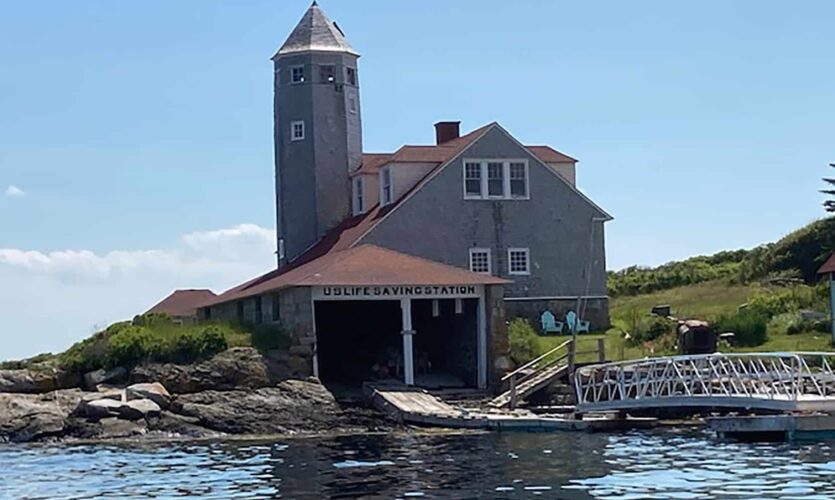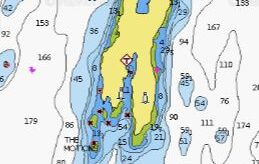Dead on the rhumbline from Cape Small to the Old Man R “2” buoy off Allen Island, Damariscove Harbor is among Maine’s most attractive. It provides access to a preserved island inhabited in summer only by two caretakers and a stunning mixture of common and rare creatures. The island features miles of well-tended trails with spectacular views, a tiny museum featuring artifacts from Damariscove’s rich human and natural history, and arguably the coast’s loveliest composting toilet. Despite its attractiveness, Damariscove is not a good place to be in a blow.
Damariscove
Approach & Cautions
Photo: Bill Wohlforth
Find the “TM” gong and steam in, slightly favoring the western shore 100 yards south of the old Lifesaving Station (now a private home) to avoid a rock.

Docking, Anchorages, or Moorings
The Boothbay Region Land Trust [BRLT] maintains two guest moorings. The mooring in the channel in front of the stone wharf is in 12.5 feet at MLW, but the narrowness of the channel warrants a stern anchor. The mooring in the inner pool, north of the dinghy dock, carries just 3.5 feet at MLW. (The Taft/Rindlaub Guide’s report of 6 feet contradicts both my and the caretakers’ observations.) The holding ground south of the stone wharf is decent, but one’s scope is limited by the proximity of private moorings. A stern anchor is strongly advised. The number of vessels that can cram in here depends on their size, the skippers’ ground tackle, risk acceptance and ingenuity — and everyone’s friendly cooperation (almost always evident). In settled weather, some opt to anchor south of the moorings at the harbor entrance, but it tends to be rolly. Note that Damariscove (pronounced locally “Dammerscove”) is popular with day-trippers who depart late afternoon or early evening. If you find the best mooring occupied, it never hurts to inquire as to intentions. Finally, although it has sheltered vessels for 400 years, it is not a good place to be in a blow.
Getting Ashore
Photo: Bill Wohlforth
Land your dinghy at the BRLT float. Maps of the island’s many trails are available at the kiosk, where you will find current information and a guest book. There are over 3 miles of trails you can explore here with large populations of seabirds and other animals including muskrats. There are over 200 acres of beautiful coastal tundra vegetation. The summer caretakers are always friendly fonts of information. Swimming is agreeable on warmer days. And here are a few warnings: At the dock entrance there are always red ants to be avoided (!)–bring bug spray just in case, and bring some skin cleaning product because there are several patches of poison ivy along the paths. They are marked but it never hurts to be prepared to have something soapy to wash with in case of contact. You can avoid a lot of grief by washing off the protein from the plant using soap and cold water within 20 minutes and that’s too far from the boat (note: alcohol gel won’t work).

Other Nearby Anchorages: Within an 8-mile range, you have many options, from Seguin Island to Robinhood/Riggs Cove or Ebenecook/Love Cove/Indiantown Island on the Sheepscot River, to Boothbay Harbor.
OUR REVIEWS



